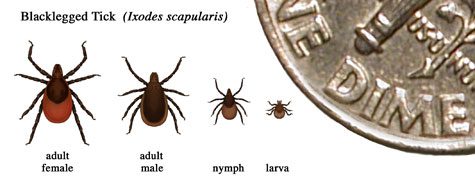Photo above from the CDC.
Message from Blogpost Author and VCPA Field Scientist, Alex Byrne: “This season within our forests our oak trees produced a significantly large mast of acorns, seen scattered across the forest and trail floors. This has many interesting ecological outcomes, one of which may be a rise in Tick numbers as their rodent host species benefit from the surplus of food available (Ostfeld et al. 2001). Please be conscious of this during the spring and summer seasons when utilizing Van Cortlandt Park, sticking to designated trails and completing tick checks if moving off the beaten path.”
Understanding some basic facts of Tick biology can go a long way in helping to reduce the incidence of Tick born disease in humans. Although there is a relatively large list of diseases vectored by different Tick species including, Anaplasmosis, Babesiosis, Powassan Disease, Rocky Mountain Spotted Fever, Colorado Tick Fever, Ehrilichiosis, Rickettsiosis and Mammalian meat allergy, it is Lyme disease that has become the focus of much research in the United States. In Northeastern North America, the Black-legged tick or Deer tick, Ixodes scapularis carries within it the bacteria Borrelia burgdorferi. B. burgdorferi is an identified agent of Lyme disease. The ticks pick up the spirochete bacteria during their nymph stage through feeding on vertebrate hosts that act as asymptomatic reservoirs for the bacteria. Most notably, deer mice in the genus Peromyscus sp. have been documented as a significant host for the bacteria. It is when the ticks drop off their rodent hosts and prepare for their third meal that humans have a problem.
The transmission of the pathogen requires a series of actions on the part of the tick and bacteria. Here is where systematic tick checks can exploit the ecology of the tick-bacteria-host relationship. Research into the life cycle of B. burgdorferi performed by scientists, such as Dr. Semay Chou at UCSF, demonstrates that substantial growth of the B. burgdorferi population occurs after the blood meal, which sets the stage for transmission. In order to retrieve the blood meal a tick must create a blood pool through generating subdermal cavities through the use of a cement like material. This entire process of feeding and bacterial population growth takes time and the full transmission cycle for I. scapularis typically occurs after 36 hours from the initial time of attachment according to a recent talk given by Dr. Chou (2019). Therefore, quick removal of a tick before the 36 hour period significantly reduces the possibility of infection.
By searching your body for ticks after a hike and removing any that are attached, you interrupt the process of cavity building, bacteria population growth and subsequent transmission. It is important to note that transmission occurs when bacteria laden saliva is regurgitated from the tick into the host, therefore care should be taken during the removal process to reduce possible regurgitation. The CDC has great guidance on proper removal. Additionally, being aware of tick habitat, typically associated with woodlands and tall grasses with a particular preference for humid environments can help you avoid areas of high density. Lastly, pets can track ticks into your home thus being vigilant with both the human and nonhuman members of the household can go a long way.
An understanding of Tick biology through research is our greatest asset in reducing tick born disease. You can identify tick species that may be picked up on a hike with the help of the app iNaturalist, with the use of a picture the app can aid you in the identification of the tick species and therefore the associated possible vectored disease. Here in VCP there is the possibility of running into the mentioned I. scapularis (Lyme Vector) and the Dog Tick, Dermacentor variabilis. Finally for additional information on ticks please see Cary Institute Ecosystem Studies page to learn more about the complexities of host relationships, disease and creative solutions now being tested to eliminate Lyme disease locally.


